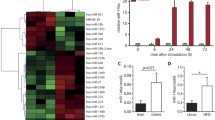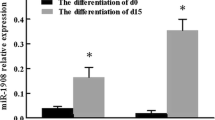Abstract
Obesity has become a global public health problem associated with complications including type 2 diabetes, cardiovascular disease, and several cancers. Adipocyte differentiation (adipogenesis) plays an important role in obesity and energy homeostasis. Adipose tissue secretes multiple cytokines and adipokines which can cause the complications of obesity, especially insulin resistance. TNF-α, IL-6, leptin, and resistin have been identified as the main regulators of obesity and insulin activity. miR-378 is highly induced during adipogenesis and has been reported to be positively regulated in adipogenesis. In the current study, matured human adipocytes were treated with TNF-α, IL-6, leptin, or resistin on the 15th day after the induction of human pre-adipocyte differentiation. We demonstrated that TNF-α, IL-6, and leptin upregulated miR-378 expression indicating that miR-378 probably is a novel mediator in the development of insulin resistance related to obesity.




Similar content being viewed by others
References
Hotamisligil, G. S., Shargill, N. S., & Spiegelman, B. M. (1993). Adipose expression of tumor necrosis factor-alpha: Direct role in obesity-linked insulin resistance. Science, 259, 87–91.
Vozarova, B., Weyer, C., Hanson, K., Tataranni, P. A., Bogardus, C., & Pratley, R. E. (2001). Circulating interleukin-6 in relation to adiposity, insulin action, and insulin secretion. Obesity Research, 9, 414–417.
Cohen, B., Novick, D., & Rubinstein, M. (1996). Modulation of insulin activities by leptin. Science, 274, 1185–1188.
Steppan, C. M., Bailey, S. T., Bhat, S., Brown, E. J., Banerjee, R. R., Wright, C. M., et al. (2001). The hormone resistin links obesity to diabetes. Nature, 409, 307–312.
Ono, K. (2011). MicroRNA links obesity and impaired glucose metabolism. Cell Research, 21, 864–866.
Gerin, I., Bommer, G. T., McCoin, C. S., Sousa, K. M., Krishnan, V., & MacDougald, O. A. (2010). Roles for miRNA-378/378* in adipocyte gene expression and lipogenesis. The American Journal of Physiology - Endocrinology and Metabolism, 299, E198–E206.
Zhao, Y. P., Zhang, C. M., Zhu, C., Chen, X. H., Wang, J. L., Ji, C. B., et al. (2010). NYGGF4 homologous gene expression in 3T3-L1 adipocytes: Regulation by FFA and adipokines. Molecular Biology Reports, 37, 3291–3296.
Chen, X., Zhu, C., Ji, C., Zhao, Y., Zhang, C., Chen, F., et al. (2010). STEAP4, a gene associated with insulin sensitivity, is regulated by several adipokines in human adipocytes. International Journal of Molecular Medicine, 25, 361–367.
Schmittgen, T. D., & Livak, K. J. (2008). Analyzing real-time PCR data by the comparative C(T) method. Nature Protocols, 3, 1101–1108.
Neville, M. J., Collins, J. M., Gloyn, A. L., McCarthy, M. I., & Karpe, F. (2011). Comprehensive human adipose tissue mRNA and microRNA endogenous control selection for quantitative real-time-PCR normalization. Obesity (Silver Spring), 19, 888–892.
Chu, N. F., Spiegelman, D., Hotamisligil, G. S., Rifai, N., Stampfer, M., & Rimm, E. B. (2001). Plasma insulin, leptin, and soluble TNF receptors levels in relation to obesity-related atherogenic and thrombogenic cardiovascular disease risk factors among men. Atherosclerosis, 157, 495–503.
Ran, J., Hirano, T., Fukui, T., Saito, K., Kageyama, H., Okada, K., et al. (2006). Angiotensin II infusion decreases plasma adiponectin level via its type 1 receptor in rats: An implication for hypertension-related insulin resistance. Metabolism, 55, 478–488.
Wellen, K. E., & Hotamisligil, G. S. (2005). Inflammation, stress, and diabetes. Journal of Clinical Investigation, 115, 1111–1119.
Kahai, S., Lee, S. C., Lee, D. Y., Yang, J., Li, M., Wang, C. H., et al. (2009). MicroRNA miR-378 regulates nephronectin expression modulating osteoblast differentiation by targeting GalNT-7. PLoS ONE, 4, e7535.
Gerin, I., Bommer, G. T., McCoin, C. S., Sousa, K. M., Krishnan, V., & MacDougald, O. A. (2010). Roles for miRNA-378/378* in adipocyte gene expression and lipogenesis. The American Journal of Physiology - Endocrinology and Metabolism, 299, E198–E206.
Lee, D. Y., Deng, Z., Wang, C. H., & Yang, B. B. (2007). MicroRNA-378 promotes cell survival, tumor growth, and angiogenesis by targeting SuFu and Fus-1 expression. Proceedings of the National Academy of Sciences of the United States of America, 104, 20350–20355.
Zaragosi, L. E., Wdziekonski, B., Brigand, K. L., Villageois, P., Mari, B., Waldmann, R., et al. (2011). Small RNA sequencing reveals miR-642a-3p as a novel adipocyte-specific microRNA and miR-30 as a key regulator of human adipogenesis. Genome Biology, 12, R64.
Stephens, J. M., Lee, J., & Pilch, P. F. (1997). Tumor necrosis factor-alpha-induced insulin resistance in 3T3-L1 adipocytes is accompanied by a loss of insulin receptor substrate-1 and GLUT4 expression without a loss of insulin receptor-mediated signal transduction. Journal of Biological Chemistry, 272, 971–976.
Mohamed-Ali, V., Goodrick, S., Rawesh, A., Katz, D. R., Miles, J. M., Yudkin, J. S., et al. (1997). Subcutaneous adipose tissue releases interleukin-6, but not tumor necrosis factor-alpha, in vivo. Journal of Clinical Endocrinology and Metabolism, 82, 4196–4200.
Muller, S., Martin, S., Koenig, W., Hanifi-Moghaddam, P., Rathmann, W., Haastert, B., et al. (2002). Impaired glucose tolerance is associated with increased serum concentrations of interleukin 6 and co-regulated acute-phase proteins but not TNF-alpha or its receptors. Diabetologia, 45, 805–812.
Steensberg, A., Fischer, C. P., Sacchetti, M., Keller, C., Osada, T., Schjerling, P., et al. (2003). Acute interleukin-6 administration does not impair muscle glucose uptake or whole-body glucose disposal in healthy humans. Journal of Physiology, 548, 631–638.
Glund, S., Deshmukh, A., Long, Y. C., Moller, T., Koistinen, H. A., Caidahl, K., et al. (2007). Interleukin-6 directly increases glucose metabolism in resting human skeletal muscle. Diabetes, 56, 1630–1637.
Friedman, J. M., & Halaas, J. L. (1998). Leptin and the regulation of body weight in mammals. Nature, 395, 763–770.
Elmquist, J. K., Elias, C. F., & Saper, C. B. (1999). From lesions to leptin: Hypothalamic control of food intake and body weight. Neuron, 22, 221–232.
Havel, P. J., Kasim-Karakas, S., Mueller, W., Johnson, P. R., Gingerich, R. L., & Stern, J. S. (1996). Relationship of plasma leptin to plasma insulin and adiposity in normal weight and overweight women: effects of dietary fat content and sustained weight loss. Journal of clinical endocrinology and metabolism, 81, 4406–4413.
Muller, G., Ertl, J., Gerl, M., & Preibisch, G. (1997). Leptin impairs metabolic actions of insulin in isolated rat adipocytes. Journal of Biological Chemistry, 272, 10585–10593.
Muller, G., Ertl, J., Gerl, M., & Preibisch, G. (2001). The hormone resistin links obesity to diabetes. Nature, 409, 307–312.
Rajala, M. W., Qi, Y., Patel, H. R., Takahashi, N., Banerjee, R., Pajvani, U. B., et al. (2004). Regulation of resistin expression and circulating levels in obesity, diabetes, and fasting. Diabetes, 53, 1671–1679.
Way, J. M., Gorgun, C. Z., Tong, Q., Uysal, K. T., Brown, K. K., Harrington, W. W., et al. (2001). Adipose tissue resistin expression is severely suppressed in obesity and stimulated by peroxisome proliferator-activated receptor gamma agonists. Journal of Biological Chemistry, 276, 25651–25653.
Haluzik, M. M., Lacinova, Z., Dolinkova, M., Haluzikova, D., Housa, D., Horinek, A., et al. (2006). Improvement of insulin sensitivity after peroxisome proliferator-activated receptor-alpha agonist treatment is accompanied by paradoxical increase of circulating resistin levels. Endocrinology, 147, 4517–4524.
Degawa-Yamauchi, M., Bovenkerk, J. E., Juliar, B. E., Watson, W., Kerr, K., Jones, R., et al. (2003). Serum resistin (FIZZ3) protein is increased in obese humans. Journal of Clinical Endocrinology and Metabolism, 88, 5452–5455.
Anderlova, K., Dolezalova, R., Housova, J., Bosanska, L., Haluzikova, D., Kremen, J., et al. (2007). Influence of PPAR-alpha agonist fenofibrate on insulin sensitivity and selected adipose tissue-derived hormones in obese women with type 2 diabetes. Physiological Research, 56, 579–586.
Ramji, D. P., & Foka, P. (2002). CCAAT/enhancer-binding proteins: structure, function and regulation. Biochemical Journal, 365, 561–575.
Choi, J. J., Park, M. Y., Lee, H. J., Yoon, D. Y., Lim, Y., Hyun, J. W., et al. (2012). TNF-alpha increases lipogenesis via JNK and PI3K/Akt pathways in SZ95 human sebocytes. Journal of Dermatological Science, 65, 179–188.
Gierens, H., Nauck, M., Roth, M., Schinker, R., Schurmann, C., Scharnagl, H., et al. (2000). Interleukin-6 stimulates LDL receptor gene expression via activation of sterol-responsive and Sp1 binding elements. Arteriosclerosis, Thrombosis, and Vascular Biology, 20, 1777–1783.
Acknowledgments
This work was supported by Grants from the National Key Basic Research Program of China (2013CB530604), the National Natural Science Foundation of China (81270928), the Program for Innovative Research Teams of Jiangsu Province (LJ201108), the Natural Science Foundation of Jiangsu Province (BK2011107), and Nanjing Technological Development Program (201104013).
Author information
Authors and Affiliations
Corresponding authors
Rights and permissions
About this article
Cite this article
Xu, Ll., Shi, Cm., Xu, Gf. et al. TNF-α, IL-6, and Leptin Increase the Expression of miR-378, an Adipogenesis-Related microRNA in Human Adipocytes. Cell Biochem Biophys 70, 771–776 (2014). https://doi.org/10.1007/s12013-014-9980-x
Published:
Issue Date:
DOI: https://doi.org/10.1007/s12013-014-9980-x




